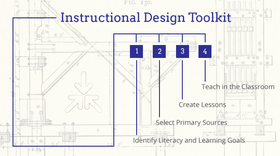Primary Source Exemplar: Nutrition and Human Rights
Overview
Students return to their lists of barriers to equal and appropriate nutritional access and link this information to the global concern for access to appropriate diets. They then make link how changes in diets can lead to negative ecological consequences.
Learning Objectives
Students will be able to evaluate if human nutrition rights are violated by analyzing political shifts in nutrition.
Students will be able to craft a proposal for human nutrition initiatives by applying research on ecologically efficient nutrition methods.
Students will evaluate possible suggestions for decreasing human impact on food webs by comparing proposals.
Standards Addressed
CCSS R-1 Cite specific textual evidence to support analysis of science and technical texts.
CCSS R-7 Integrate quantitative or technical information expressed in words in a text with a version of that information expressed visually (e.g., in a flowchart, diagram, model, graph, or table).
CCSS W-1 Write arguments focused on discipline-specific content.
CCSS W-7 Conduct short research projects to answer a question (including a self-generated question), drawing on several sources and generating additional related, focused questions that allow for multiple avenues of exploration.
HS-LS2-7 Design, evaluate, and refine a solution for reducing the impacts of human activities on the environment and biodiversity.
Instructional Approach
Primary Source Interpretation – Global Malnutrition
Introduce the lesson by asking students to return to the prior work they completed listing the barriers to equal and appropriate nutritional access. Introduce the Introduction to the World Health and CDC Growth Charts paper, which is based on the malnutrition data sets and emphasizes the multiple ways children can be malnourished, as well as presents data tools that can be used to measure those rates.
By including this intro, student research and the Universal Declaration of Human Rights, the class can outline how this problem is of global concern. The introduction of the paper has significant academic language such as “adequate” and “adverse”, which should be examined through contextual evidence and direct instruction. Students will be asked to use formal language when writing their proposal.
Guiding Questions
The following guiding questions may be used to guide a close reading by the students:
What parameters are used to classify malnutrition rates?
How are the indicators grouped, what do they mean, and how do they contribute to your understanding of malnutrition?
What words or phrases do you not understand that hinder your understanding of the text as a whole?
Which issues regarding malnutrition do you feel are most urgent?
Synthesizing Information – Food Webs and Ecological Impact
Direct Instruction needed
To address concerns of lack of food and poor access to food (perhaps addressing food deserts?), tie these concerns back to the food web and the effects on other populations. Students should explore what would happen if we grew more corn/wheat/rice with probing questions from the teacher. For example, “What would happen to the population of insects?” or “What is needed to grow more corn/wheat/rice/livestock?” By exploring these questions, students can identify that changes in one aspect of the food web leads to changes in other aspects. After students understand the need for fertilizer and pesticides to help crops grow, address the concepts of bioaccumulation/biomagnification (abiotic, nonliving chemicals) and the impact on other parts of the ecosystem.
Synthesizing Task
Students write a proposal that focuses on nutrition shifts at a local scale. By introducing the concept of farmers’ markets, guide students in evaluating the ecological efficiency and practicality of the solution while also identifying possible barriers (such as not accepting EBT [previously called food stamps]).
In this writing assignment, students choose a scenario where nutrition shifts are possible (such as an athlete or team preparing for a big game, a family’s weekly meals or a food pantry providing assistance) and design healthy alternatives to traditional meals.
Students should be able to identify how shifts can occur in ecological efficiency with attention to evolutionary trends such as taste.
The proposal should include how the nutritional shift may impact a specific population’s human rights, either negatively or positively.
Students can write or record their proposals and present it to the desired audience.
Students may spend time in small groups brainstorming or giving feedback along the process.
Assessment
Students will have:
Read closely a primary source document by the CDC
Outlined access to proper diets as a global concern
Explored how changes in diet can negatively impact an ecosystem
Teachers can evaluate students’ progress by:
Monitoring students’ close reading of the text by asking follow-up questions.
Giving feedback on student analysis of how barriers to nutrition are a global human rights issue to ensure students are incorporating issues locally and globally.
Monitoring whether students can see how changing one component of the food ecosystem can interrupt an ecosystem.
Adaptations
Students may compile a class list of barriers and then narrow the barriers as a class to eliminate extra confusion with the number of steps. The same could also be applied to the selection of solutions and the selection of possible mitigations.
Supports
Students could be provided with defined words or technology to support their reading of the introductory paragraphs.
Students could be guided to specific websites such as the FDA or the NIH to aid with identifying risk mitigation for agricultural practices.
